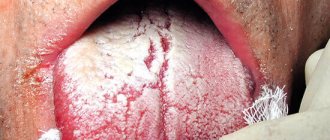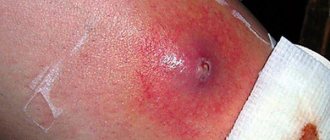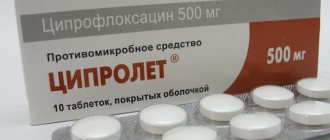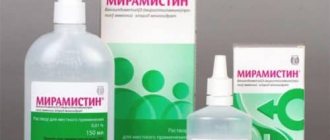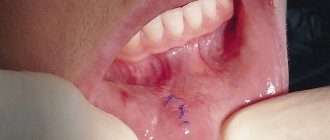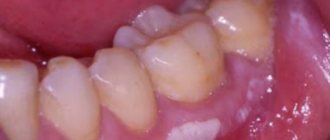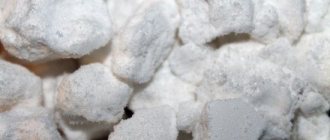Symptoms
Pus on the tonsils appears in acute tonsillitis or sore throat.
The causative agents of the disease and purulent plaque are bacteria. Tonsils have a barrier and protective effect; when pathogenic microorganisms enter, they do not allow them to pass into the respiratory tract.
https://www.youtube.com/watch?v=-bvI0f46nA0
Plugs with pus are a symptom, not the cause of the disease; sore throat with complications develops with reduced immunity.
In acute tonsillitis, accompanied by purulent plaque, the following symptoms are observed:
- Pain in the throat that gets worse when swallowing and talking.
- The throat area becomes red and swollen, followed by pus.
- Increased body temperature often reaches 40 degrees. A sore throat causes headache, general weakness and chills.
- Enlarged and painful lymph nodes under the jaw.
Pus is formed with follicular and lacunar tonsillitis, and with the catarrhal form of the disease there are no plugs.
A sore throat is one of the symptoms of pus on the tonsils.
Often, purulent plugs on the tonsils are difficult to confuse with anything else. But it is still worth identifying the symptoms of pathology:
- Specific odor from the mouth. This symptom can be used to determine the presence of the disease by people who have already encountered this problem more than once.
- Pain when swallowing. This symptom appears only in advanced stages, when the size of the purulent plugs is too large. The disease cannot be brought to this stage; if there is the slightest discomfort, consult a doctor. Often the patient feels the presence of a foreign object in the throat.
- White spots. During a routine examination, it is impossible to see purulent plugs on the tonsils; only a doctor can make the correct diagnosis and detect purulent formations. However, often purulent plugs appear in the form of white spots on the tonsils. In this case, even a routine home examination will reveal the disease.
- Purulent tonsillitis is accompanied by high fever, chills, headaches, and nausea.
Pus on the tonsils is a specific disease, therefore, if a person has had to get sick at least once in his life or observed such a phenomenon in someone, then it cannot be confused with other diseases.
The main reason for the appearance of pus and purulent plugs in the lacunae of the tonsils is the active activity of harmful bacteria. The cause of the disease is determined by an analysis such as a smear from the larynx. The appearance of purulent plugs is provoked by a general weakening of the immune system, diseases of the nasopharynx and oral cavity.
| Disease | Description | Symptoms |
| Angina | Tonsillitis. Occurs due to the active activity of harmful bacteria. It is divided into follicular and lacunar. Sometimes a sore throat occurs, which manifests itself in both forms at the same time. Lacunar tonsillitis is accompanied by a white coating and yellow pus. Follicular - redness of the tonsils and small pustules. |
|
| Pharyngitis | Inflammation of the back wall of the throat with the formation of purulent plugs. It occurs due to infectious infection, weak immunity, predisposition, and even due to environmental pollution. |
|
| Fungal infections | Infections of the pharyngeal mucosa with Candida fungi. Enters the body by airborne droplets. |
|
| Tonsillitis | Infectious disease of the upper respiratory tract. Infection occurs both infectiously and from chronic caries and sinusitis. |
|
The causes of purulent plugs on the tonsils are bacteria such as staphylococcus, hemolytic streptococcus, pneumococcus, and chlamydia. You can find out which bacteria caused the appearance of purulent plugs using a smear from the larynx. Most often the disease develops due to other pathologies of the respiratory tract. Infection is possible:
- By airborne droplets;
- Autoinfection.
The general clinical signs for each form of the disease are similar. The difference lies precisely in the morphological changes determined by objective examination. Moreover, all inflammatory processes in the tonsils differ in the nature and depth of the lesion, and the involvement of various structures in the process. In this regard, they are divided into catarrhal, purulent and necrotic. The latter form is extremely rare, only in weakened patients.
The pharyngoscopic picture, corresponding to the catarrhal form of tonsillitis, is characterized only by enlargement and redness of the tonsils. There are no plaques or plugs indicating a purulent lesion. Follicular and lacunar tonsillitis are accompanied not only by redness and enlargement of the tonsils, but also by the formation of purulent deposits on them.
With purulent tonsillitis, the patient’s general condition noticeably worsens, symptoms of intoxication and hyperthermia increase, and pain in the throat intensifies. Lymphadenopathy is noted not only upon palpation, but also at rest. These factors force us to look for ways out of the current situation.
At this stage, it is important to consult an otolaryngologist who will diagnose and prescribe the correct treatment. If we are talking about the presence of purulent foci on the tonsils, and the process is limited to these formations, most likely we are talking about a bacterial pathogen. In this case, antibiotics cannot be avoided. At the same time, the lack of correct treatment can lead to the transition of acute tonsillitis to a chronic form.
Why does purulent plaque occur?
Pathogenic microbes multiplying in the throat actively affect the mucous membranes, changing their color to white, gray and yellow. Purulent spots, rashes, films covering the tonsils cause:
- Microorganisms:
- diphtheria bacillus;
- staphylococcus;
- Pneumococcus;
- streptococcus.
- Colds:
- pus-like plaque on the tonsils occurs against the background of a sharp decrease in immunity or hypothermia;
- Fungi;
- Herpes virus;
- Adenoviruses, rhinoviruses
However, the throat does not always turn white due to a pathological lesion. For example, this situation often occurs in infants after breastfeeding. The reason is the staining of the oropharynx with food debris.
Dangerous procedures
It is necessary to remove pus from the tonsils in severe cases of the disease in a medical facility. Ulcers are containers where there is a large accumulation of various bacteria. After two days of antibiotic therapy, pathogenic microorganisms are destroyed. When the infection is defeated, the pus stops secreting, and the plugs disappear after 3–4 days.
If you do not remove the inflammation from a purulent sore throat, but simply start fighting the traffic jams, the patient’s condition will only worsen. There is a risk of reappearance of purulent discharge on the tonsils, and irritation and inflammation of the mucous membrane will cause an increase in temperature.
The situation will lead to the spread of infection and damage to the mucous membrane. When you cleanse your throat with hard objects on your own, the pus seeps even deeper.
We invite you to read: Severely burned tongue, palate, lips, throat: what to do, what helps with burns of the oral cavity? How to relieve pain from a burn and treat a burned tongue, palate, lips, throat: tips, folk recipes
The procedure for getting rid of purulent plaque is simple; its difficulty lies in carrying out the manipulation yourself in compliance with all sanitary standards.
How to deal with ulcers at home:
- Use a hard object to press on the area near the plug; a white liquid will appear on its surface.
- The object must be surgical tweezers, a pencil, a teaspoon handle.
- The manipulation is carried out near a mirror in a illuminated place. A person's hands must be completely free.
- It is necessary to disinfect the item by wiping it with alcohol.
- Tweezers or a spatula should be wrapped in a piece of sterile bandage, after moistening it in Furacilin or another antibacterial agent.
- The object is brought to the throat carefully, because the abscess is removed with the slightest pressure.
After the manipulation, it is necessary to clean the tonsils from any remaining pus, so the throat is gargled with chamomile decoction, saline solution, and Furacilin. If you use hydrogen peroxide, then after the procedure you will also have to wash off this medication.
No less dangerous are attempts to mechanically squeeze out pus from the tonsils. This procedure is carried out using a spatula. At home, patients who want to recover as quickly as possible and are not familiar with the course of the disease use a spoon for this. By applying pressure to the tonsil, pus flows out of the lesion. These attempts do not always lead to the leakage of pus, but are always accompanied by trauma to nearby tissues.
An extremely dangerous action is to try to remove pus by puncturing the abscess.
Patients use a regular needle for this, at best, treated with an antiseptic solution. When performing such a puncture, pressure is applied to nearby tissues, which promotes the flow of pus.
This is a very painful and dangerous procedure, as a result of which you can injure the oral mucosa or tongue. Even if it is carried out successfully, there is a significant risk of infection spreading and the formation of wounds or ulcers at the site of the puncture. It is these actions that can cause the development of a tonsil abscess and the need for surgical intervention.
Self-removal of ulcers for angina is not only pointless from the point of view of clinical effectiveness, but also poses a rather serious danger. Even if you manage to open the purulent follicle and more or less efficiently clean it of the contents, an unprotected wound surface will form in this place.
In addition, removing ulcers at home is almost always a rather rough process associated with extensive damage to the mucous membrane. Even if it seems to the patient that such manipulations are performed very carefully, in reality this is not the case.
Intense mechanical trauma leads to the development of additional foci of inflammation, prolongation of the disease and deterioration of the patient's condition.
Finally, severe damage to the mucous membrane caused by attempts to remove purulent follicles on the tonsils usually heals very poorly. In this case, rough scars and scars are formed. These elements significantly impede the normal outflow of fluid from the lacunae on the surface of the tonsils, which often leads to chronic tonsillitis, and sometimes even becomes a reason for surgical intervention.
Removal of ulcers can only be carried out by a doctor, guided by serious indications. In a hospital setting, special instruments and careful treatment of the tonsils are used at the end of the procedure.
Causes of pathology
With some ailments, white pustules may appear on the tonsils, what is it? Most often, pus on the tonsils is accompanied by an increase in temperature. The most common causes of this pathology are:
- Angina. This is the most common disease that causes pus in the tonsils. The causative agents of the disease can be staphylococci and streptococci. They become the root cause of the tonsils beginning to fester. It is extremely easy to get this disease. Especially if the person’s immune system is weakened. Sore throat can be caused by both a microbial infection and a viral one. For this reason, it is necessary to start treatment only after consultation with a specialist.
- Chronic tonsillitis. In this case, the abscess on the tonsils will be accompanied by an unpleasant odor from the oral cavity. This situation will be aggravated by food debris that remains on the tonsils. This environment is an excellent environment for the proliferation of pathogenic bacteria.
Pharyngitis and laryngitis as a result of freezing are also the causes of ulcers on the tonsils.
Pus on the tonsils without fever indicates:
- Presence of injuries. Often, solid foods damage the mucous membrane of the tonsils. That's why they start getting sick. For example, it could be a cracker or a fish bone. With good immunity, the resulting wound heals very quickly. If the patient’s immunity is weakened, then a purulent process occurs.
- Fungal diseases. Abscesses on the tonsils without fever may indicate the progression of a fungal infection. Usually the resulting plaque is thrush. The root cause of this pathology is improper use of medications. Externally, the plaque is very similar to liquid pus, but as such it is not.
- Cysts. With this pathology, seals appear on the tonsils. Externally, such seals look like pustules, but there are no pathogens in them. Such tumors must still be removed, as they can become cancerous. In addition, there is discomfort when swallowing.
- Diseases of gums and teeth. Dental ailments also become the root cause of the formation of ulcers in the throat without fever. With caries and periodontal disease, white ulcers may appear on the tonsils and in the oral cavity. Such neoplasms act as ulcers. When the cause of their occurrence is eliminated, treatment is carried out promptly.
- Plaque from food consumed. Sometimes food debris on the tonsils is mistaken for purulent plaque. Especially if the person consumed fermented milk products. In this case, it will be enough to simply rinse your mouth.
We invite you to find out how much braces cost on the upper jaw for a teenager
Depending on the form of the disease that accompanies the ulcers, the symptoms are expressed differently. In the acute form, the most common symptoms are:
- increased body temperature;
- sharp pain in the tonsils;
- repulsive odor from the mouth;
- difficulty swallowing;
- general intoxication of the body.
In the chronic course of the disease, purulent plugs on the tonsils are not accompanied by symptoms.
Traditional methods of treatment
ENT doctors are constantly faced with the fact that patients or their relatives seek to remove pus from the tonsils at home. Typically, such actions are performed using gauze wrapped around a finger, mechanically scraping off the plaque. In some cases, hydrogen peroxide, Lugol's solution or furatsilin are used for this.
All these actions do not so much remove existing plaque as they injure surrounding tissues. In addition, these drugs have an irritating effect on the mucous membrane, increasing pain. It is unknown whether such a procedure will clear the tonsils of plaque, but it will certainly have a damaging effect on nearby tissues.
Procedures that are also not recommended include attempting to cleanse the tonsils using honey dissolved in water. Although honey is not irritating, bacterial pathogens, staphylococci and streptococci, thrive in sweet solutions of glucose and fructose. In addition to traumatizing surrounding tissues, such manipulation will contribute to an even greater spread of infection. We should not forget about beekeeping products as a powerful allergen.
There are many proven ways to treat purulent sore throat with homemade products and plants.
Chamomile and calendula decoction. To prepare the medicine, you will need to pour 2 tbsp into a small saucepan. l. herbs, pour 1 liter of boiling water over it and simmer the mixture over low heat for half an hour. The infusion cools for 2–3 hours, after which you need to start gargling.
Kalanchoe and aloe. Plants have anti-inflammatory properties. For the medicine you will need their leaves, which are more than three years old. The greens are crushed and squeezed, and the resulting juice is diluted with 1 glass of water. This natural product relieves swelling.
At high temperatures, as well as if purulent plugs cause discomfort, they should be removed immediately. In the absence of such symptoms, you can simply gargle with a medicinal solution.
In any case, it is necessary to use a vitamin complex to restore immunity. Self-medication is strictly prohibited.
Medication
The most common treatment method is antibiotics.
The most common treatment method is penicillin-based antibiotics (amoxicillin, flemoxin). Before starting drug treatment, you should consult with your doctor; a specialist will determine the appropriate medications and make the correct diagnosis. This will reduce the risk of complications.
We suggest you read: Washing the tonsils, how often to do it
In addition to antibiotics, the doctor will prescribe painkillers and antipyretics that will eliminate symptoms and ease the course of the disease, and will also select a vitamin complex.
- To combat symptoms, ibuprofen, aspirin or paracetamol are prescribed.
- The mouth should be rinsed with solutions of furatsilin and miramistin.
- Sprays hexarol, ingalipt.
- Faringosept, Strepsils, and Lizobact lozenges will relieve symptoms.
Surgery
Surgical removal of purulent plugs
Surgery to treat purulent plugs on the tonsils is a rare occurrence. Modern medicine has come a long way and removal of diseased organs is no longer required. However, in complex and advanced situations, one cannot do without the help of a surgeon.
The operation to remove purulent formations takes place quickly, using local anesthesia. General anesthesia is used only if a child is being operated on. Rehabilitation after surgery lasts no more than a week and includes taking vitamins and proper nutrition.
Physiotherapy
UHF of the tonsils
Recently, physiotherapy has gained particular popularity in the treatment of purulent plugs on the tonsils.
Laser, magnetic therapy, and UHF are used for treatment.
Only a doctor can prescribe such treatment.
ethnoscience
To remove pus from the tonsils, after the doctor’s approval, you can turn to traditional medicine:
- Recipe No. 1 Mix half a teaspoon of baking soda and salt with water;
- Add a couple of drops of iodine.
- Regularly rinsing your mouth with this solution will reduce purulent plugs.
- Pour crushed propolis (30 g) into 200 ml of alcohol or vodka.
- Brew a tablespoon of sage in boiling water, like tea.
- Chamomile infusion is brewed in a ratio of 2 tbsp. spoons of pharmaceutical chamomile / 250 ml of boiled water.
- Brew 100 grams of dried yarrow in a water bath with 750 ml of water. Cook for half an hour.
Food should be liquid, not hot or spicy.
Nutrition during and after illness should help restore and strengthen the body. To do this, you should adhere to the following rules:
- Due to the fact that swallowing is difficult during the disease, food should be liquid and semi-liquid.
- Food should be warm and nutritious. The diet should include fruits and vegetables; they are rich in vitamins.
- We must not forget about animal proteins.
- Avoid salty and spicy foods.
- Drink more liquids: teas, juices, milk with honey.
Medicines for tonsillitis
In order to completely “defeat” the disease and not face a relapse, you need to be treated comprehensively, following all the recommendations prescribed by your doctor. In complex therapy of sore throats, the following are used:
- Antibiotics. The main goal of antibiotic therapy is to destroy beta-hemolytic streptococcus in the oropharynx. With a correctly prescribed course of antibiotics, the symptoms of the disease disappear quickly and complications do not develop. A doctor should prescribe an antibiotic to a patient with acute tonsillitis after the etiology of the infection has been laboratory confirmed. An incorrectly selected drug can blur the clinical picture and contribute to the development of resistant flora. The duration of the course and the optimal dosage of the drug are determined by the doctor individually depending on the age, body weight of the patient and the degree of damage to the tonsils. Under no circumstances should you interrupt the course or arbitrarily reduce the dosage.
- Antiseptic drugs. Used to relieve inflammation in the throat and remove pus. It is necessary to gargle every hour; the procedure helps to mechanically remove the pus that is constantly secreted from the inflamed lacunae of the glands. For rinsing, aqueous solutions of Furacilin, Stomatodin, Chlorhexidine, Miramistin, Rotokan, Stopangin, Streptocide or Yoddicerin are used.
- Medicines to relieve sore throat. The most commonly used are dissolving tablets. For tonsillitis, they act as an analgesic; lacunar tonsillitis cannot be cured with them. For adult patients, the drugs Faringosept, Neo Angin, Falimint, Strepsils, Travisil, Chlorophyllipt are suitable.
- Antipyretics and painkillers. Typically medications containing ibuprofen or paracetamol are used. Their use is advisable when body temperature exceeds 38 °C. At home, drinking plenty of fluids effectively reduces the temperature; herbal decoctions and teas that have an antiseptic effect are suitable.
We suggest you familiarize yourself with Dry mouth: the causes of which disease
In addition to the listed medications, the treatment regimen for purulent sore throat includes vitamin complexes with minerals, immunomodulators, glucocorticosteroid drugs, and folk remedies intended to eliminate local symptoms (inhalations, rinsing).
If treatment of purulent sore throat is carried out at home, it must be agreed with a doctor. Doctors recognize the high effectiveness of folk recipes for rinsing and inhalation and often prescribe them as aids in the treatment of sore throat.
Medicinal preparations for rinsing
It is easy to get rid of purulent plugs with plain water, but it is recommended to use medications to rinse the throat. This remedy will remove plaque, destroy the causative agent of the disease and improve the condition of the mucous membrane during a sore throat.
There are several common preparations for rinsing with purulent sore throat.
- Potassium permanganate. To prepare the liquid, you will need to dissolve a couple of potassium permanganate crystals in 200 ml of warm water. The dosage is calculated for one rinse. It is recommended to filter the solution so that the grains do not scratch the already affected throat. Rinsing is carried out 4 times a day.
- Saline solution. For a sore throat, this is the most popular remedy; to prepare it, you need to dilute 1 tsp in 200 ml of warm water. soda and salt. For a quick effect, add a couple of drops of iodine to the liquid. The procedure is carried out 4 times a day, combined with other medications.
- Boric acid. To prepare the solution, pour 2.5 grams of 1% dry product into a glass of warm water. The liquid is used for rinsing with ulcers 3 to 5 times a day.
- Chlorophyllipt. The natural-based drug has an anti-inflammatory, immunostimulating and restorative effect. Add 1 tsp to a glass of warm water. medical product. It is necessary to gargle three times a day; it perfectly removes surface deposits.
- Furacilin. The drug tablet is crushed and dissolved in a glass of warm water. The product is used 2 to 4 times a day.
- Chlorhexidine. The drug has an antiseptic effect. Before using it, it is recommended to gargle with warm boiled water and brush your teeth. For the procedure, take a 0.05% solution, which you need to gargle for 30 seconds and spit it out.
It is prohibited to use different medications for purulent sore throat without first consulting a doctor. Some products can be harmful to the body. Inhalipt, due to its increased viscosity, slows down the discharge of pus.
In order to remove superficial deposits of pus from the tonsils, it is not so important what exactly to gargle with. After all, this effect is exerted by the liquid itself. The washing technique is much more important:
- The temperature of the solution should be comparable to the normal temperature of the human body (36-370C) or slightly exceed it (up to 500C).
- The washing procedure must be performed about 6 times a day and must be done after meals.
- The duration of each rinse should be approximately 2-3 minutes.
- Do not use aggressive chemical solutions or apply too much force during the rinsing process. Excessive chemical or mechanical irritation of the tonsils will slow down healing.
Although almost any neutral liquid can be used to remove purulent plaque from the tonsils, it is most convenient to use solutions that have additional healing properties. Thanks to this, you will receive several therapeutic effects at once that will help with sore throat. Liquid compounds that have anti-inflammatory, analgesic and disinfectant effects are usually used:
- sodium chloride solution, including 1 teaspoon of ordinary salt dissolved in half a liter of water;
- baking soda solution (1 tsp baking soda per 1 liter of water);
- mixture of 1 tsp. soda and 1 tsp. salt in 1 glass of water with the addition of 2-3 drops of iodine;
- infusions and decoctions of medicinal herbs and plants - calendula, rose hips, St. John's wort, chamomile, oak bark, yarrow, sage, oregano, coltsfoot, etc.;
- a solution of potassium permanganate, including 5-6 granules of dry potassium permanganate, diluted in 1 glass of water;
- solutions of boric acid, furatsilin, chlorophyllipt, chlorhexidine, stopangin and other pharmaceutical drugs.
We suggest you read: Bad breath after tooth extraction - what to do?
For sore throat with a purulent component, Lugol's solution or Ingalipt should not be used. These substances are characterized by increased viscosity due to the presence of glycerol and for this reason, on the contrary, make it difficult to remove pus from the surface of the tonsils.
Rinses to the rescue
Rinsing is an indispensable procedure in the treatment of sore throat. This manipulation performs many important functions: mechanically cleanses the mucous membrane of pathogenic microorganisms and their toxins, moisturizes and warms. Depending on the main active component included in the rinse solution, it has anti-inflammatory, antimicrobial, antibacterial, wound healing, regenerating and many other effects.
By washing, you can effectively remove plaque from the tonsils. To do this, you should use special preparations, infusions of medicinal herbs or ordinary boiled water. Thanks to mechanical action, the mucous membrane is cleansed of various deposits and effectively moisturized. To achieve the most pronounced positive result, you should adhere to certain rules:
- Fluid temperature. Under no circumstances should you use hot or cold water. It should be at room temperature to make the procedure as comfortable and painless as possible. This will eliminate the possibility of a burn to the mucous membrane or progression of the disease.
- Rinse frequency. The treatment of sore throat should be approached responsibly, so the procedure must be carried out at least 5-6 times a day. This should be done after eating. Indeed, in addition to the plaque that appears, rinsing will also remove food debris from the oral cavity.
- Time of procedures. The duration of rinsing is 3-5 minutes. This is enough to remove superficial pus from the tonsils. If there are purulent follicles, you should consult a doctor, since it is absolutely impossible to completely remove the formation by rinsing.
- Compound. The main limitation to the manipulation is that it is strictly forbidden to use aggressive substances. With their help, you can provoke a burn of the inflamed mucous membrane of the throat. In addition, the procedure should be carried out carefully, without undue enthusiasm, so as not to damage the vulnerable surface.
Pus on the tonsils in a child
Children are more susceptible to diseases than adults, because children's immune systems are not yet fully developed. This also applies to the protective functions of the body. Therefore, if you have any symptoms, you should immediately consult a doctor to prescribe proper treatment.
The disease can be diagnosed after laboratory tests. You should take a blood test and a throat swab. If a child does not have other symptoms, such as fever and acute pain, this does not mean that there is no need to see a doctor. If there are purulent formations, you should consult a specialist to avoid serious complications.
Doctors also recommend visiting an ENT specialist and a dentist at least once every six months, as well as teaching your child to brush their teeth twice a day.
Washing tonsils in the ENT office
Cleaning the tonsils at home is quite difficult - it is more of an easy prevention than a thorough treatment. Washing in the doctor’s office is considered the most effective. To do this, several different procedures are carried out:
- douching of the tonsils. This washing of the tonsils using a syringe with a special bent needle is done by analogy with cleaning with an irrigator. The doctor directs the syringe into the canals and quickly squeezes the solution out of it so that the pressure of the liquid washes away the purulent formations;
- vacuuming the tonsils. This method of cleaning lymphoid tissue on an outpatient basis brings the best results. A special pad is placed on the tonsil, into which a solution is poured under pressure. The liquid is immediately sucked out and a vacuum is formed inside the pad, which helps the stones to easily leave the lacunae;
- a comprehensive cleaning method - vacuuming using ultrasound and subsequent administration of medications. When the plugs are too hard and sit deep in the lacunae, ultrasound helps soften their contents, and the medicinal solution, which is injected into the tonsils after the procedure, promotes their rapid healing.
Cleaning tonsils from plugs in a clinic using the “Tonsillor” device, which performs vacuuming, allows you to forget about chronic tonsillitis for a long time. Just one course of treatment lasting 10 procedures is often enough for the disease to go into a state of stable remission.
What drugs are used
If the tonsils are inflamed and their surface is hyperemic, rinsing is carried out with an antibiotic solution with an antiseptic. This approach allows you to quickly relieve the inflammatory process and reduce the activity of the bacterial flora. If cleaning the tonsils is carried out when a person is healthy and his throat does not bother him, then an antiseptic solution is sufficient.
The washing liquid must have a hypoallergenic composition, not leave burns and at the same time effectively fight pathogenic microflora. Typically, doctors use Furacilin, Miramistin, bacteriophages or Chlorhexidine. If the patient is overly sensitive, the larynx is sprayed with lidocaine spray. Hydrocortisone ointment is used to heal the tonsils.
Contraindications
Rinsing tonsil lacunae in the hospital has a number of contraindications. The hardware effect affects the functioning of the lymphatic system and temporarily reduces the resistance of local immunity. Therefore, clearing your throat is prohibited for the following ailments:
- at the beginning and end of pregnancy - it is recommended to treat the tonsils only in the second trimester;
- arterial hypertension;
- atherosclerosis;
- severe infectious diseases;
- oncology;
- tuberculosis;
- ARVI.
Sore throat and the acute phase of a respiratory disease are a direct contraindication to self-sanitation of the larynx.
Cleaning the tonsils can be done both at home and in the office of an otolaryngologist. There are many ways to sanitize the throat, but not all of them are effective.
If you have frequent tonsillitis, you should pay attention to hardware lavage of the tonsils - this is one of the most effective methods. If a sore throat is a rare occurrence, you can stick to home hygiene and visit an otolaryngologist from time to time for preventive purposes.
Possible complications
Cellulitis of the neck
Purulent formations are dangerous because they spread through the circulatory and lymphatic systems, which leads to diseases of the kidneys, heart or joints. Treatment cannot be put off for a long time; if the disease is neglected, the following complications are possible:
- Peritonsillar abscess. If pus gets into the tissue, the neck begins to swell and the pain intensifies. Treatment requires surgery, which involves suctioning out the pus.
- Mediastinitis. Pus enters the neck, thereby causing swelling of the tonsils, which makes breathing difficult. This complication can be fatal.
- Cellulitis of the neck and general blood sepsis.
- Septic arthritis.
Do not delay treatment; at the slightest symptoms, you should consult a doctor.
Cautions and Limitations
When treating purulent plugs on the tonsils, you should pay special attention to some restrictions. If pus remains on the tonsils when gargling, there is no way to forcefully get rid of it. Several manipulations with rinsing will help remove purulent plugs without damaging the mucous membrane. During manipulation, it is easy to damage the surface of the shell.
Purulent tonsillitis is treated only under the supervision of a physician. Therapy includes a set of rinses, medication, and traditional medicine recipes.
Severe bacterial tonsillitis is accompanied by the accumulation of pus on the tonsils. But the amount of these deposits and their prevalence do not in any way affect the patient’s condition; the main symptoms of the disease are caused by the inflammatory process.
With the help of properly prescribed therapy, the pus will disappear on its own in a few days. Complex treatment, including the use of rinsing, rubbing and other methods, will help to achieve a speedy recovery for a person.
The need to cleanse the tonsils
Antibiotic therapy leads to the fact that within 1-2 days from the start of taking these medications, there is an improvement in the general condition, a decrease in temperature, and clearing of ulcers from the tonsils.
No additional effort is required to remove pus from the tonsils.
Thus, there is no need to remove ulcers yourself due to the fact that
- Painful sensations are not caused by their presence, but by the inflammatory process occurring in the tonsils. This is confirmed by catarrhal tonsillitis, which occurs without the formation of ulcers, but with severe pain and symptoms of intoxication;
- Removing ulcers without antibiotic therapy will not improve the situation and will not prevent the development of complications of the disease. At the same time, prescribing appropriate treatment directed against the pathogen will contribute to a speedy recovery.
Unprofessional actions to remove pus from the tonsils are very dangerous. They are accompanied by additional trauma, severe pain, and, in addition, lead to the formation of an extensive wound surface, the formation of scars and the transition of the disease to a chronic form.
In this case, the use of antibiotics may not be enough. The only effective method to treat this pathology is surgical intervention. However, such a treatment can only be carried out by a specialist in the appropriate department.
How to remove pus from tonsils yourself at home
Extracted purulent plugs
If it is not possible to see a doctor or purulent plugs are a common problem, you can remove the pus yourself. In the initial stages, superficial pustules can be removed by rinsing the mouth with special decoctions and infusions, which are either sold in pharmacies or can be made independently. Procedure:
- Wash your hands, treat the instruments that will be used in the process of removing purulent plugs with an antiseptic or regular alcohol.
- Prepare a mirror, spoon, bandage and antiseptic.
- To remove pus, you will need a medical spatula, but not every first aid kit has such a tool, so you can use an ordinary clean pencil or a plastic stick.
- Wrap a bandage pre-moistened in antiseptic on a prepared medical spatula or its alternative.
- If there is no medical antiseptic in the first aid kit, you can use honey and salt.
- The spoon is needed to press the tongue. It should not interfere during the procedure.
- Use a spatula to gently press on the purulent formations. If the pus does not begin to stand out, you should simply remove it with a bandage from the surface of the tonsils. The main thing is to act carefully and squeeze out the pus without damaging the mucous membrane.
- After all purulent formations have been removed, after squeezing, you need to gargle hourly to protect open wounds from harmful microbes.
What are purulent plugs? Reasons for education
Tonsilloliths are formed in the tonsils and are small formations that accumulate in the lacunae (depressions) of the organ during tonsillitis and chronic tonsillitis. Their formation begins in the lacunae, where leukocytes and neutrophils begin to fight pathogenic, pyogenic microbes. In the lumens of the lacunae, desquamated epithelium, leukocytes, microbes and their decomposition products, protein masses and mucus accumulate.
Caseous plugs are separate yellowish formations that are located at the mouths of the lacunae. Their composition is identical to that of pus. Due to the deposition of minerals (including calcium salts), purulent areas become denser. A similar picture often occurs with chronic tonsillitis and is a reason to immediately seek medical help.
Traffic jams sometimes form in healthy people. They are dense and do not cause bad breath. Due to the organ’s ability to self-cleanse, treatment is not required in this case.
Rice. 4. The photo shows purulent plugs in the tonsils.
Rice. 5. The photo shows purulent plugs extracted from the lacunae of the tonsils.
Tonsillitis is an inflammatory process in the tonsils. The disease can be acute or chronic. The acute form is better known as tonsillitis. In chronic cases, periods of exacerbation (inflammation of the tonsils) are replaced by periods of remission (calm). Most often, the disease occurs in children 5-15 years old, although adults are also susceptible to the disease.
The tonsils in children are larger than in adults. The palatine tonsils reach their maximum size by the age of 7, and then begin to shrink. Constant viral attacks on the tonsils lead to tonsillitis. Chronic tonsillitis most often acts as a complication after an infectious disease (sore throat, caries, etc.).
Medicinal preparations for rinsing
Opening and squeezing out purulent follicles on your own is very dangerous. At home, you cannot completely remove all the contents and clear your throat well. As a result of damage to the integrity of the mucous membrane, an unprotected wound surface is formed in the throat. It is an open gate for pathogenic bacteria to enter.
There is a high risk of developing an abscess, especially when pus penetrates deep into the tissue. Its occurrence can provoke a severe deterioration in the patient’s well-being. And the only method of getting rid of the problem is surgical intervention - opening the abscess.
Treatment of angina should be comprehensive and carried out under the supervision of a specialist. You should listen to your doctor's recommendations. This will help speed up the patient’s recovery and prevent the development of complications and side effects.
Main symptoms
Abscesses can merge and enlarge. In this case, there may be severe pain in the throat, burning, and there is a smell of rot from the mouth.
Another characteristic symptom is fever. During inflammation, bacteria and viruses release toxic substances that are carried throughout the body through the bloodstream, thereby causing fever, weakness, chills, and malaise.
Symptoms vary depending on the disease.
For purulent sore throat:
- Temperatures can reach up to 39 degrees.
- The throat is swollen, with pain when swallowing.
- A catarrhal form of sore throat without plaque, with small pustules, is possible.
- Lacunar form: dense formations are formed - lacunae. Purulent contents accumulate in them.
- Accompanied by inflammation of the jaw lymph nodes.
With chronic tonsillitis there may be:
- Unpleasant smell of sulfur from the mouth
- Acute pain when swallowing
- Taste of pus in the mouth
In a child, inflammation in the tonsils often occurs against the background of persistent colds, sore throats, and tonsillitis.
What does pus on the tonsils without fever indicate? Pus in the throat without fever is a rather alarming sign, which indicates that the body is not fighting inflammation.
Cases that occur without inflammation:
- In older people, due to decreased function of the laryngeal mucosa (atrophy), there may be no temperature.
- Chronic sluggish tonsillitis without inflammation during the period of weakening of the disease.
- If the pharynx is damaged (for example, by a fish bone). A whitish coating forms on the injured area.
- During long-term treatment with antibacterial agents, thrush, a fungal disease, may occur.
- Cystic lesions on the tonsils.
- Inflammations in the oral cavity, such as periodontal disease, caries, stomatitis. Ulcers appear on the palate, larynx, and tonsils.
Return to contents


